The official claim that the banks have met an agreed SME loan target is simply untrue, writes Karl Whelan.
Ever since it was acknowledged that the Irish banking sector was in crisis, successive governments have proclaimed that their policy measures would “get credit flowing again”. First Nama and then the large-scale recapitalisation that occurred last year were both explained to the public as necessary steps to ensure that Irish banks were able to lend properly, in particular to the important small and medium-sized (SME) sector.
In recent months, government politicians have been declaring that AIB and Bank of Ireland have met a target agreed with the Government that each would lend €3bn to SMEs in 2011. The source of the confirmation that these targets have been met appears to be the head of the credit review office, John Trethowen.
Sadly, however, it seems to me that Mr Trethowen is not correct that the banks have met the targets that they agreed. New figures from the Central Bank show that total new lending to SMEs from all banks in Ireland, not just AIB and Bank of Ireland, was €4.3bn in 2011. Total new lending to SMEs, excluding lending to financial intermediaries (which I’m guessing is closer to what the bank commitments actually referred to) was €3.1bn in 2011. Whichever total you look at, new loans in 2011 were well short of the €6bn that would have been obtained if AIB and Bank of Ireland had met their targets, even if no other bank had made a loan to an SME.
How can Trethowen argue that the targets for new lending have been met when the statistics show that they haven’t? The answer is that Trethowen is counting existing loans that have been restructured in his totals. Indeed, he has said that restructurings account for the majority of the total amount of loans that he has counted.
Did the original agreement with banks include restructurings in the total agreed? A quick look at AIB’s announcement of their agreement makes it clear that the answer is no. This announcement stated that the bank had agreed to “make available €3bn in new or additional credit to SMEs”. Elsewhere in their statement, the bank noted that it was “already providing considerable lending support to SMEs in both new lending and in the re-scheduling and restructuring of their existing borrowings”. This statement makes it clear, when the agreements were made, AIB were drawing a distinction between restructuring of existing loans and “new lending”.
So why are the banks failing to meet their lending targets? One possibility is that it has become impossible for the pillar banks to meet their SME lending commitments because they have since agreed the PLAR (Prudential Liquidity Assessment Review) programme with the troika, which aims to reduce the quantity of loans on their balance sheets .
In fact, the PLAR targets do not explain why SME credit has been so tight. The banks did not agree to increase their total stock of SME loans by €3bn each in 2011, but rather to make €3bn each in new loans. The Central Bank figures show that the repayments of loans by SMEs that are not financial intermediaries, totalled €6.1bn last year, so that the total stock of outstanding loans for this category declined by €2.9bn. The banks could have made far more SME loans without much expansion in their balance sheet.
The actual reduction in credit to SMEs goes well beyond what was agreed in last year’s PLAR. That agreement focused largely on reducing the non-core assets of the banks.
AIB\EBS were only to reduce core Irish lending by €1.1bn by the end of 2013, while Bank of Ireland were to reduce core lending by €2.6bn. The Central Bank figures suggest that the pillar banks have reduced SME credit in one year by almost as much as they were supposed to reduce their total loan books in three years.
Trethowen has argued in his reports that focusing on new lending by banks would be a mistake because there simply isn’t sufficient demand for credit from viable firms. The key word here is “viable” because the evidence suggests that plenty of firms are applying for credit and being turned down. A survey released by the Central Statistics Office showed that in 2010 only 55% of SMEs that applied for credit were fully successful in their applications, down from 95% in 2007. With evidence that credit is still being squeezed, it is likely that success rates have declined further since 2010.
The banks may complain that they can’t be expected to make loans to non-viable businesses.
However, there is an element of vicious circle in the current set of policies. Indigenous non-exporting SMEs account for 57% of private sector employment. If these firms cannot obtain reasonable access to credit then they may fail and further increase unemployment, which in turn will lead to weakening demand for the goods and services provided by other SMEs and threaten their viability.
It is time for Minister Noonan to call in the heads of the pillar banks, one of which is fully owned by the State, and ask for clear explanations as to why new lending to SMEs has been so weak.
The Irish people have paid a very heavy price for the mistakes made by bankers and regulators.
It is hardly too much to expect that the banks that they have saved honour solemn public commitments to support the small local firms that are crucial to our economic success.






